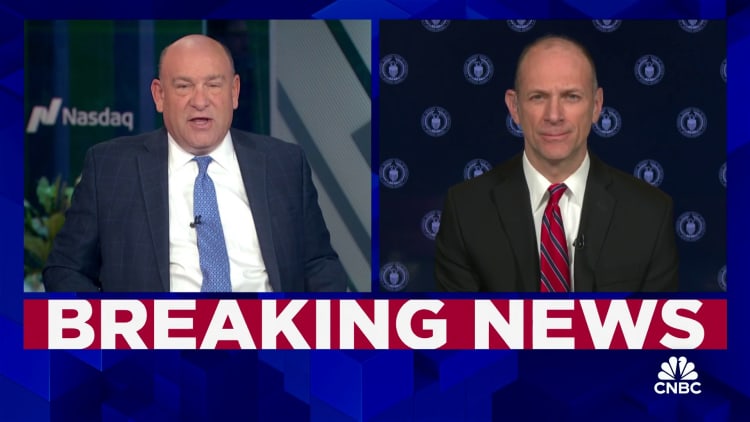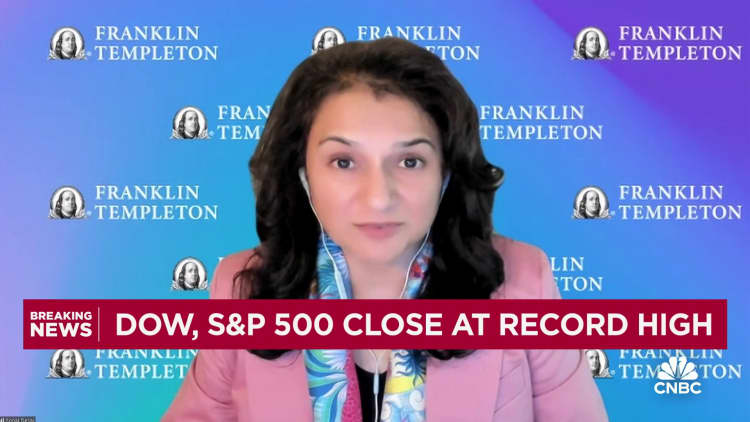
Traders work on the floor at the New York Stock Exchange (NYSE) in New York City, U.S., January 19, 2024.
Brendan Mcdermid | Reuters
Markets have become less convinced that the Federal Reserve is ready to press the button on interest rate cuts, an issue that cuts at the heart of where the economy and stocks are headed.
Two big economic reports coming up this week could go a long way toward determining at least which way the central bank policymakers could lean — and how markets might react to a turn in monetary policy.
Investors will get their first look at the broad picture of fourth-quarter economic growth for 2023 when the Commerce Department releases its initial gross domestic product estimate on Thursday. Economists surveyed by Dow Jones are expecting the total of all goods and services produced in the U.S. economy to grow at a 1.7% pace for the final three months of 2023, which would be the slowest growth since the 0.6% decline in Q2 of 2022.
A day later, the Commerce Department will release the December reading on the personal consumption expenditures price index, a favorite Fed inflation gauge. The consensus expectation for core PCE prices, which exclude the volatile food and energy components, is 0.2% growth for the month and 3% for the full year.

Both data points should garner a lot of attention, particularly the inflation numbers, which have been trending towards the Fed’s 2% goal but aren’t there yet.
“That’s the thing that everybody should be watching to determine what the Fed’s rate path will end up being,” Chicago Fed President Austan Goolsbee said during an interview Friday on CNBC. “It’s not about secret meetings or decisions. It’s fundamentally about the data and what will enable us to become less restrictive if we have clear evidence that we’re on the path to get” inflation back to target.
Lowered rate-cut outlook
The releases come amid a market snapback about where the Fed is heading.
As of Friday afternoon, trading in the fed funds futures market equated to virtually no chance the rate-setting Federal Open Market Committee will cut at its Jan. 30-31 meeting, according to CME Group data as indicated through its FedWatch Tool. That’s nothing new, but the odds for a cut at the March meeting fell to 47.2%, a steep slide from 81% just a week ago.
Along with that, traders have taken one expected cut off the table, reducing the outlook for easing to five quarter percentage point decreases from six previously.
The change in sentiment followed data showing a stronger-than-expected 0.6% growth in consumer spending for December and initial jobless claims falling to their lowest weekly level since September 2022. On top of that, several of Goolsbee’s colleagues, including Governor Christopher Waller, New York Fed President John Williams and Atlanta Fed President Raphael Bostic, issued commentary indicating that at the very least they are in no hurry to cut even if the hikes are probably done.

“I don’t like tying my hands, and we still have weeks of data,” Goolsbee said. “Let’s take the long view. If we continue to make surprising progress faster than was forecast on inflation, then we have to take that into account in determining the level of restrictiveness.”
Goolsbee noted that one particular area of focus for him will be housing inflation.
The December consumer price index report indicated that shelter inflation, which accounts for about one-third of the weighting in the CPI, rose 6.2% from a year ago, well ahead of a pace consistent with 2% inflation.
However, other measures tell a different story.
A new Labor Department reading known as the New Tenant Rent Index, tells a different story. The index, which measures prices for new leases that tenants sign, showed a 4.6% decline in the fourth quarter of 2023 from a year ago and more than double that quarterly.
Watching the data, and other factors
“In the very near term, we think the inflation data will cooperate with the Fed’s dovish plans,” Citigroup economist Andrew Hollenhorst said in a client note.
However, Citi foresees inflation as stubborn and likely to delay the first cut until at least June.
While it’s unclear how much difference the timing makes, or how important it is if the Fed only cuts four or five times compared to the more ambitious market expectations, market outcomes have seem linked to the expectations for monetary policy.
There are plenty of factors that change the outlook in both directions — a continued rally in the stock market might worry the Fed about more inflation in the pipeline, as could an acceleration in geopolitical tensions and stronger-than-expected economic growth.
“By keeping the potential alive for inflation to turn up, these economic and geopolitical developments could put upward pressure on both short-term rates and long-term yields,” Komal Sri-Kumar, president of Sri-Kumar Global Strategies, said Saturday in his weekly market note.
“Could the Federal Reserve be forced to raise the Federal Funds rate as its next move rather than cut it?” he added. “An intriguing thought. Don’t be surprised if there is more discussion along these lines in coming months.”
